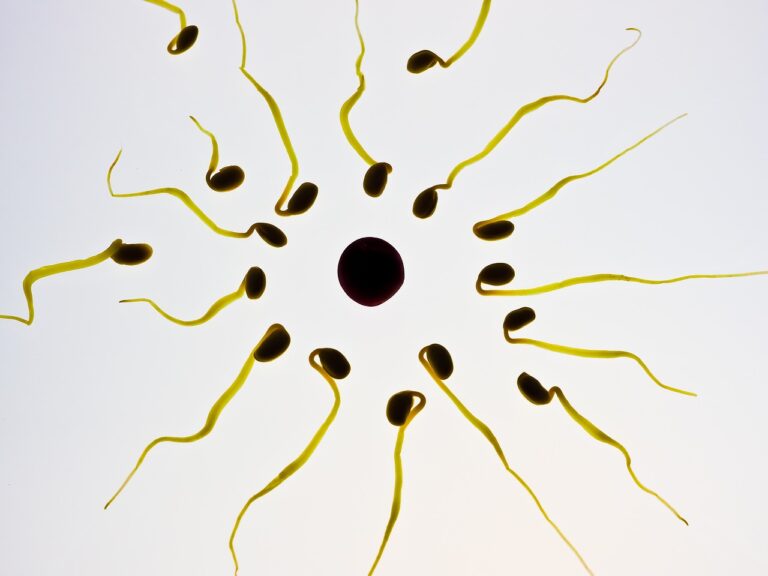If all the sperm cells in one ejaculation lined up end to end, they would stretch six miles. Fortunately, sperm cells don’t live long once they reach the egg.
But they sure do produce a lot of them! Normally, a man’s testicles produce about 200 million sperm every day.
How big is a sperm cell?
When you think of sperm cells, you probably picture something tadpole-like — with a bulbous “head” and narrow tail. But a sperm cell is actually far too small to be seen without a microscope. Each sperm is just 0.002 inches (or 50 micrometers) from head to tail.
What sperm cells lack in size, they make up for in numbers. In fact, if you lined up all the sperm cells from one ejaculation end to end they would stretch six miles.
The average sperm is about 4 to 5 micrometres long and 2 to 3 micrometres wide, although there is some variation among species. The head of a sperm contains enzymes to help it penetrate an egg and carry genetic information, called chromosomes. The chromosomes determine a baby’s gender and general physical traits.
Sperm cells can vary dramatically in size, and this may be related to the relative sizes of the testicles and gonads. For example, chimpanzees have huge gonads relative to their body size, while gorillas have tiny ones.
The shape of the sperm head also varies. In humans, it is flattened and almond-shaped, four to five micrometres long and two to three micrometres wide. The sperm head is covered with a cap known as the acrosome. To be considered normal, a sperm head should have a smooth oval outline and not be too round or long. The cap should cover no more than 20% of the head area, and there should be no vacuoles in the post-acrosomal region.
How many sperm cells are in an ejaculation?
It may be surprising to know that sperm cells are not very big. However, what they lack in size they make up for in numbers. As a result, one man’s ejaculation may contain tens of millions of sperm. In addition, a single sperm cell can fertilize an egg cell, which is how babies are made.
Men produce sperm cells all throughout their lives. When they ejaculate, these tadpole-shaped sperm are carried in fluid that is called semen. This is a mixture of secretions from the seminal vesicles, the prostate gland, and the bulbourethral glands. It is composed of water, protein, sugar, potassium, calcium, magnesium, sulfur, zinc, and prostaglandins.
Each day, thousands of sperm are produced in the testicles and are nourished until they are ready for ejaculation. An ejaculation has a volume of about half a teaspoon and each milliliter contains between 20 million and 150 million sperm cells.
It is important to note that a man’s sperm count can affect how fertile he is, which is why it is important for him to stay healthy and eat foods that are high in zinc. This is because the zinc in these foods will help increase sperm production. Men’s sperm production slows down as they get older. As a result, the sperm they produce is less likely to be viable when they reach the woman’s vagina.
How do sperm cells get to the egg?
It takes something like 30 minutes to several hours for a single sperm cell to reach the egg and fertilize it. This is a big reason why it’s important to have a high number of motile sperm cells. A man with a low sperm count is unlikely to get pregnant even if he’s been abstinent for a long time.
The journey to the egg starts when a man’s semen (containing sperm) exits through the opening at the tip of his penis or urethra. Ejaculation then pushes the semen (containing sperm) into the vagina towards the cervix where it’s carried there by natural mucus. From there, the sperm cells swim through the cervix and uterus and eventually enter the fallopian tubes.
Once in the fallopian tube, a sperm cell has a single goal – to meet up with an egg cell. This isn’t easy, because the sperm must make its way through many barriers. For example, a sperm cell can die if it gets stuck in the vaginal walls, and the egg can also be protected by a layer of epithelial cells.
But for every thousand sperm that enter the fallopian tube, only about 200 will be lucky enough to penetrate and fertilize an egg. This may explain why natural selection drives sperm production sky-high, in order to increase the odds of finding an egg that’s ready to be fertilized.
How do sperm cells fertilize an egg?
When sperm are released they swim to the egg, which is held in the female reproductive tract inside the woman’s body. Once the sperm reach the egg they face tight competition. Hundreds of sperm cells will surround the egg cell in a fierce battle until one breaks through the outer membrane. Then the sperm cell and the egg cell fuse to form a single cell called a zygote. This is the first step in pregnancy.
But how do the sperm cells get so close? One favoured explanation is that sperm are competing in a kind of arms race, with natural selection driving sperm numbers sky high in a macho pursuit of the fertilisation prize. This idea is based on the observation that sperm cells have to wave their tails at least 1000 times just to travel 1.25 cm or a half an inch, a very slow rate of movement.
However, the reason this is not enough to explain the close proximity of sperm to the egg cell is that the egg has its own tough defences. The outer layer of the egg is known as the zona pellucida and it has two important functions. Firstly, the zona contains sperm receptors that are specific for human sperm. Secondly, once penetrated by a sperm, the zona changes its properties and becomes impermeable to penetration by other sperm.
See Also:






